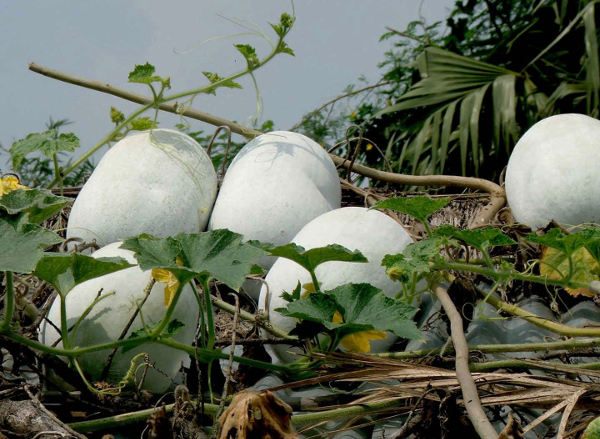With Durga puja round the corner, lunchtime will soon mean queuing up at pandals for bhog. Most bhog or naivedyam recipes tell stories that are deeply personal and have almost nothing to do with Vedic literature. Others are firmly rooted in texts which, on further research, highlight a medicinal or agrarian context to the bhog. The layers of beliefs deposited on them often completely obliterate their simple, core functions.
Some of the recipes that have been forgotten are related to the rituals of sacrifice, once an integral part of worship of the Mother Goddess, and of its Tantric and Aghora belief systems. But while researching sacrificial offerings for the devi a few years ago, some interesting mentions came up regarding the ash gourd or wax gourd. It seems the chalkumro, Bengali for ash gourd, has been included as a substitute for animals in sacrifice, entrenching its place on the bhog platter.
In ancient times, as rituals of animal sacrifice were challenged by Jainism, Buddhism and later Vaishnava sects, the sacrifice of ash gourd instead became the norm. One reason was that its shape somewhat resembles the animal torso. In keeping with the symbolism, in many places the sacrificial ash gourd is pierced with four sticks for legs and a small one for the tail. Vermilion is sprinkled over the exposed watery flesh so that its trail mimics the trail of blood. The ritual of breaking an ash gourd outside the house during Navratra/Devipaksha or housewarming is symbolic of the animal sacrifice offered during new beginnings. It is believed to ward off the evil eye.
The significance of this vegetable in Vedic culture becomes apparent in its Sanskrit name—kusmanda, synonymous with the Devi Kusmanda, believed to be the fourth form of the Mother Goddess and the creator of the universe. The name literally means “the tiny egg of energy” and is symbolic of the first atoms.
Kusmanda is also mentioned in the Nilamata Purana (sixth-eighth centuries BC) as being a common part of diet in ancient Kashmir (Kasmira). The Pancharatra text, Ishwara Samhita (eight-ninth centuries), refers to the use of kusmanda in offerings or bhog. The text describes ash gourd cooked in hot ghee with powdered peppers and cumin. This is one of the first bhog recipes of ash gourd, a pointer to its significance in the rise of Vaishnava belief, which took precedence over Shakta and Shaiva beliefs and formed the core of Brahminical Hinduism.
However, the predominant way in which the sacrificial ash gourd is cooked for bhog during Durga pujo in Bengal is with mustard paste and in mustard oil. This departure from the Vaishnava prescription of cooking in ghee is perhaps a remaining assertion of the Shakta trait, where mustard is associated with warding off evil and protection of women. The exceptions are in Vaishnava households that worship the goddess Durga.
The ash gourd also has significant everyday medicinal value. According to Charaka, in his Charaka Samhita Sutrasthana (chapter 27), a classical Ayurveda work, the plant is part of the sakavarga group of medicinal plants that is ingested as a vegetable (saka). Charaka defined these groups (vargas) based on the dietary value of the plant. According to him, it alleviates all the doshas, three elements present in the body. According to Raja Nighantu (13th-14th centuries AD), ash gourd restored health to the fatigued and worn-out parts of the body. It is an aphrodisiac, cures lack of hunger and wasting, gives strength and is anti-pitta. It is considered high on prana, or life energy.
Interestingly, the ash gourd is full of nutrients that are critical to health—96% of it is life-giving water. It has beneficial vitamins and minerals, including vitamin C and B-complex vitamins such as niacin, thiamine and riboflavin, and is a rich source of minerals like iron, potassium, zinc, calcium and magnesium. The gourd also provides a good amount of protein, carbohydrates and dietary fibre.
Perhaps it is all these qualities as well as its shape that made the yogis of yore put the weight of sacrifice on the otherwise humble and rather bland ash gourd.
Tanushree Bhowmik is a Delhi-based development professional who documents and revives old recipes through the pop-up Fork Tales.
Source: LiveMint
Image Courtesy: Celkau
You may also like
-
India Against Mpox
-
Combination of ‘Siddha’ Drugs Reduces Anemia in Adolescent Girls: Study
-
Suspected Mpox Case Under Investigation; Patient Put Under Isolation, No Cause for Alarm
-
Prime Minister Applauds India’s Best Ever Performance at the Paralympic Games
-
National Exit Test (NExT) for Ayush to be Effective from 2021-2022 Batch: Union Minister of Ayush Shri Prataprao Jadhav
